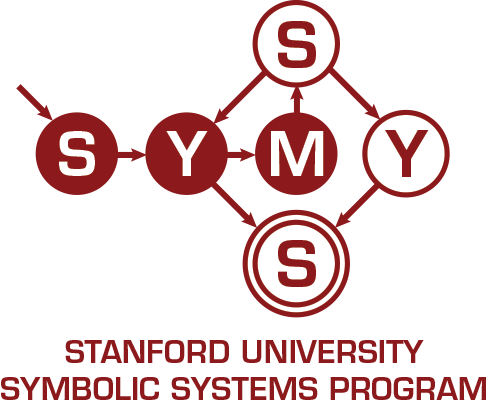[Updated July 23, 2015 - Core area lists updated to reflect changes in major core]
To declare a minor in Symbolic Systems, you must be a matriculated Stanford undergraduate who is not majoring in Symbolic Systems. Stanford undergraduates with a SUNET ID can declare via Axess.
Requirements
Students may minor in Symbolic Systems by completing either Option 1 or Option 2 below, subject to the University Policy on Minors. See also the Introductory Skill Requirements course list.
- One course in each of the following core areas (please note that several of these courses have prerequisites):
- Cognition: One of the following.
- SYMSYS 100. Introduction to Cognitive and Information Sciences (same as LINGUIST 144, PHIL 190, PSYCH 35)*
- PSYCH 45. Introduction to Learning and Memory
- PSYCH 50. Introduction to Cognitive Neuroscience
- Logic and Computation: One of the following.
- PHIL 150. Basic Concepts in Mathematical Logic (same as PHIL 250)
- PHIL 151. First-Order Logic (same as PHIL 251)
- CS 103. Mathematical Foundations of Computing
- Computer Programming: One of the following.
- CS 106B. Programming Abstractions (same as ENGR 70B)
- CS 106X. Programming Abstractions (Accelerated) (same as ENGR 70X)
- CS 107. Computer Organization and Systems
- Philosophical Foundations: One of the following.
- SYMSYS 100. Minds and Machines (same as LINGUIST 144, PHIL 190, PSYCH 35)*
- PHIL 80. Mind, Matter, and Meaning
- Linguistic Theory: One of the following.
- LINGUIST 105. Phonetics (same as LINGUIST 205A)
- LINGUIST 110. Introduction to Phonetics and Phonology
- LINGUIST 120. Introduction to Syntax
- LINGUIST 121A. The Syntax of English
- LINGUIST 121B. Crosslinguistic Syntax
- LINGUIST 130A. Introduction to Semantics and Pragmatics (same as LINGUIST 230A)
- LINGUIST 130B. Introduction to Lexical Semantics
- SYMSYS 184. Syntactic Theory and Implemetation (same as LINGUIST 184)
- Computation and Cognition: One of the following.
- BIOE341. Computational Neural Networks (discontinued)
- CS121. Introduction to Artificial Intelligence (discontinued)
- CS 221. Artificial Intelligence: Principles and Techniques
- CS 222. Rational Agency and Intelligent Interaction (same as PHIL 358)
- CS 224M. Multi-Agent Systems
- CS 227. Knowledge Representation and Reasoning
- CS 228. Probabilistic Graphical Models: Principles and Techniques
- CS 229. Machine Learning
- LINGUIST 180. From Languages to Information (same as CS 124, LINGUIST 280)
- LINGUIST 182. Computational Theories of Syntax (same as LINGUIST 282)
- PSYCH 204. Computation and Cognition: the Probabilistic Approach
- PSYCH 209. Neural Network and Deep Learning Models for Cognition and Cognitive Neuroscience
- PSYCH209A. The Neural Basis of Cognition: A Parallel Distributed Processing Approach (discontinued)
- PSYCH 239. Formal and Computational Approaches in Psychology and Cognitive Science
*SYMSYS 100 may not be counted for both areas a and d.
- Both of the following:
- SYMSYS 100. Introduction to Cognitive and Information Sciences (same as LINGUIST 144, PHIL 190, PSYCH 35)
- Plus an interdisciplinary concentration listed on the Symsys website. To qualify, the selection of courses used for the minor must be interdisciplinary; i.e., it must either include courses from at least three departments, or include more than one course from each of two departments.

 Undergraduate Minor - Symbolic Systems
Undergraduate Minor - Symbolic Systems